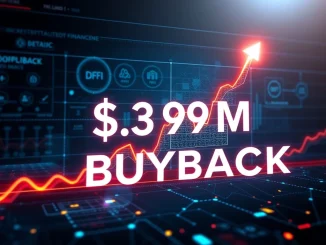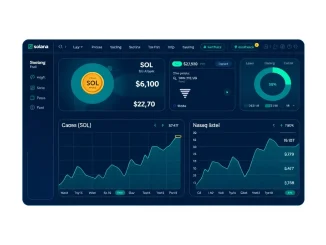
Big news for users and holders in the decentralized finance space! Aevo, a prominent decentralized derivatives exchange, has announced a significant move that impacts its tokenomics and ecosystem health. Following the successful approval of the AGP-2 proposal, Aevo is set to resume monthly on-chain buybacks. This decision, shared via their official communication channels, signals a renewed focus on supporting the AEVO token and engaging with its community through transparent, on-chain mechanisms. If you’re involved with Aevo or simply tracking key developments in the decentralized exchange landscape, this is a development worth understanding.
What Prompted the Aevo On-Chain Buybacks?
The decision to restart the buyback program is directly linked to the approval of Aevo Governance Proposal 2 (AGP-2). Governance proposals are crucial mechanisms in decentralized protocols, allowing token holders to vote on key decisions affecting the platform’s future. AGP-2 specifically addressed the allocation of protocol revenue and the implementation of a token buyback strategy. The community’s vote in favor of this proposal empowers Aevo to use a portion of the revenue generated from trading fees to purchase AEVO tokens directly from the market.
This move wasn’t arbitrary. It reflects a commitment to the value proposition of the AEVO token and aims to create a more sustainable ecosystem. By using protocol revenue for buybacks, Aevo is essentially distributing value back to token holders, albeit indirectly, by potentially reducing circulating supply or adding buying pressure.
Understanding the Significance of On-Chain Buybacks
Traditional companies often conduct stock buybacks, but doing this on-chain in the crypto world adds layers of transparency and trust. An on-chain buyback means the entire process – from the allocation of funds to the execution of trades – is recorded on the blockchain. This provides verifiable proof of the buybacks occurring as planned, reducing reliance on centralized entities and increasing confidence among participants.
For Aevo, implementing on-chain buybacks means:
- Transparency: Anyone can verify the buyback transactions on the blockchain explorer.
- Decentralization: The process is executed based on smart contract logic, reducing manual intervention after the governance approval.
- Commitment: It demonstrates Aevo’s dedication to its token holders and the long-term health of the ecosystem by utilizing generated revenue.
This differs from off-chain methods where details might be less accessible or require trust in the executing party. The on-chain nature aligns with the core principles of a decentralized exchange.
How Do Buybacks Impact the AEVO Token?
The primary goal of a token buyback program is often to create positive pressure on the token’s price. When Aevo uses its revenue to buy AEVO tokens from the open market, it increases demand for the token. If these purchased tokens are subsequently removed from circulation (e.g., burned or held in a treasury), it can also reduce the available supply, further contributing to potential price appreciation, assuming constant or increasing demand.
However, it’s important to view buybacks as just one factor influencing token price. Market sentiment, overall crypto market conditions, platform usage, competition, and future developments on Aevo will also play significant roles. While buybacks can be a powerful tool for token value accrual, they are not a guaranteed path to price increases.
Here’s a simplified look at the potential impact:
| Action | Potential Effect on AEVO Token |
|---|---|
| Aevo uses revenue to buy AEVO | Increases buying pressure/demand |
| Purchased AEVO is removed from circulation (e.g., burned) | Decreases circulating supply |
| Increased demand + Decreased supply (potentially) | Positive impact on token price (ceteris paribus) |
| Increased confidence from community | Improved sentiment and potential long-term holding |
The monthly cadence of the buybacks provides a consistent, predictable event that market participants can factor into their analysis.
The Role of Crypto Governance in Strategic Decisions
This entire process highlights the growing importance of crypto governance in decentralized protocols. The fact that the resumption of buybacks required a community vote via AGP-2 demonstrates a commitment to decentralized decision-making. Token holders, who have a vested interest in the platform’s success, get a say in how revenue is managed and how the tokenomics evolve.
Effective governance is vital for the long-term health and legitimacy of a decentralized exchange like Aevo. It allows the protocol to adapt to changing market conditions, implement features requested by the community, and ensure that strategic decisions align with the interests of those who hold and use the platform’s native token.
AGP-2 is an example of governance working as intended – a proposal was put forth, discussed, voted upon by AEVO holders, and the approved action is now being implemented on-chain for full transparency.
Looking Ahead: What This Means for Aevo and the DEX Landscape
The resumption of monthly on-chain buybacks positions Aevo as a decentralized exchange actively working to enhance its token’s utility and value proposition through transparent, community-approved methods. This could serve as a model for other DEXs looking for sustainable ways to manage protocol revenue and engage their token holders.
For Aevo users and AEVO token holders, this means a portion of the trading fees they contribute will now be recycled back into supporting the token. It aligns the incentives of the platform’s operators, users, and investors more closely.
While the immediate price impact is always subject to broader market forces, the strategic decision to implement transparent, on-chain buybacks based on community governance is a positive signal for the maturity and future direction of the Aevo platform.
Conclusion: A Strategic Step Forward for Aevo
Aevo’s decision to resume monthly on-chain buybacks, following the clear mandate from the community via the AGP-2 proposal, marks a significant step. It reinforces the platform’s commitment to transparent, decentralized operations and demonstrates a clear strategy for utilizing protocol revenue to benefit the ecosystem and the AEVO token. As the decentralized finance space continues to evolve, mechanisms like community governance and transparent on-chain buybacks will likely become increasingly important indicators of a protocol’s health and long-term viability. This move by Aevo is a strong example of these principles in action.



